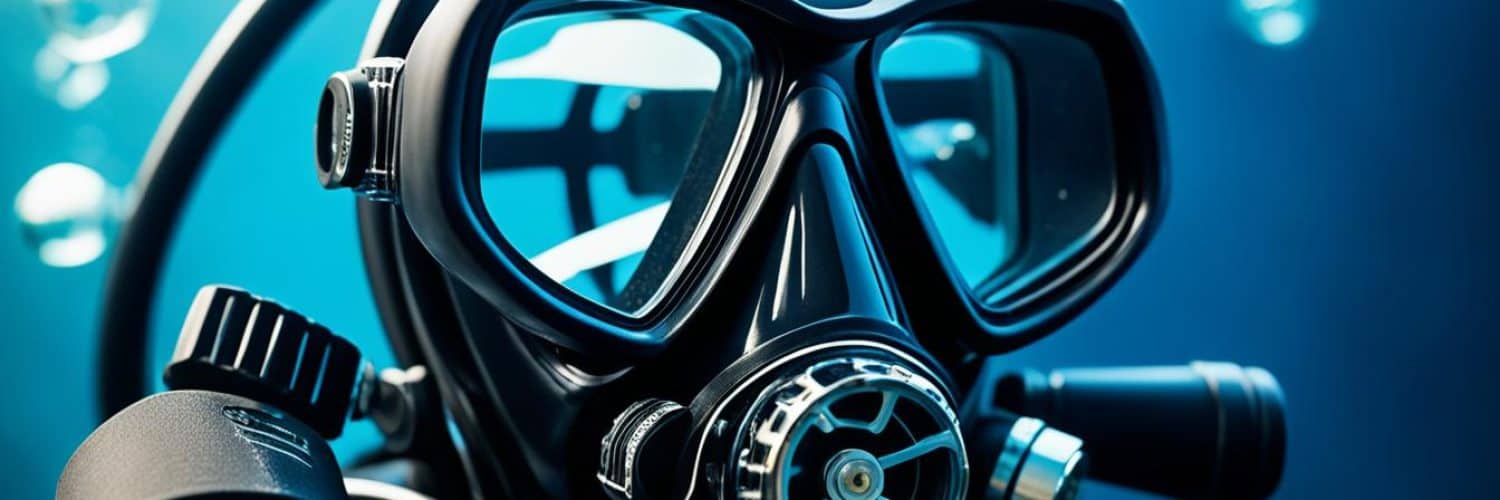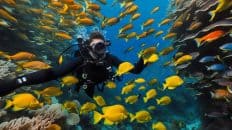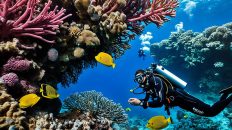Are you ready to take your scuba diving adventures to the next level? One of the most important pieces of gear you’ll need is a reliable scuba regulator. The right regulator can make all the difference in your underwater experience, providing you with a smooth and effortless breathing system that allows you to concentrate on exploring the beautiful underwater world.
When it comes to choosing the best scuba diving regulator, there are several factors to consider. Whether you’re a seasoned diver or just starting out, it’s important to find a regulator that suits your specific needs and preferences. From the type of setup to the diving environment and budget, each factor plays a critical role in determining the regulator that’s right for you.
Key Takeaways:
- Choosing the right scuba regulator is crucial for a safe and enjoyable diving experience.
- Consider the type of setup (DIN or yoke), the diving environment, and your budget when selecting a regulator.
- Ensure ease of breathing and compatibility with the gases you’ll be using.
- In colder water temperatures, opt for an environmentally sealed or cold-water specific regulator.
- Choose a balanced regulator for deep dives and an unbalanced regulator for shallower dives.
What to Look for When Buying Scuba Regulators
When it comes to scuba diving, having the right regulator is essential for a safe and enjoyable experience. Whether you’re a beginner or an experienced diver, choosing the right scuba diving regulator is crucial. Here are some key factors to consider when buying scuba regulators:
- Type of Setup: The first decision you’ll need to make is whether you prefer a DIN or yoke setup. DIN regulators offer a more secure connection to the tank and are suitable for divers using high-pressure tanks. Yoke regulators, on the other hand, are more common and versatile, making them a popular choice for recreational divers.
- Diving Environment: Consider the diving environment you’ll be exploring. Saltwater or freshwater? Cold or warm water? Different regulators are designed to perform optimally in specific conditions. For example, if you plan to dive in cold water, you’ll need a regulator that is specifically designed to withstand lower temperatures.
- Budget: Determine your budget before starting your search. Regulators come in a wide range of prices, so it’s important to find one that fits within your budget while still meeting your requirements.
- Ease of Breathing: Breathing effortlessly underwater is essential. Look for regulators that provide easy breathing without unnecessary resistance. This will enhance your diving experience and reduce fatigue.
- Compatibility with Gases: If you’re planning on engaging in decompression diving or using different gas mixtures, ensure that the regulator you choose is compatible with the gases you’ll be using.
“Choosing the right scuba regulator involves considering various factors such as the setup, diving environment, budget, ease of breathing, and gas compatibility. These factors will help you find a regulator that suits your individual needs, ensuring a safe and enjoyable diving experience.”
| Factor | DIN Setup | Yoke Setup |
|---|---|---|
| Type of Connection | Secured connection to the tank | Versatile and common |
| Environment | Best for high-pressure tanks and cold water | Common and suitable for recreational divers |
| Budget | Wide range of prices | Wide range of prices |
| Ease of Breathing | Depends on the specific model | Depends on the specific model |
| Gas Compatibility | Depends on the specific model | Depends on the specific model |
DIN vs Yoke: Which Setup is Best for You?
When it comes to choosing the right scuba diving equipment, including the dive regulator, one crucial factor to consider is the type of setup. The two most common setups are DIN (Deutsches Institut für Normung) and yoke (also known as A-clamp or international clamp). Each setup has its advantages and is best suited for specific diving conditions and tank types.
The DIN Setup
The DIN setup features a threaded connection that screws directly into the cylinder valve. It is commonly used with steel tanks and is known for its added safety and stability. The DIN regulator provides a higher-secured connection, reducing the risk of accidental detachment, especially during deeper dives.
Some key benefits of using a DIN setup include:
- Stronger and more secure connection
- Prevents accidental detachment
- Compatible with higher-pressure cylinders
- Ideal for technical diving and cold-water environments
However, it’s important to note that DIN regulators require a specific cylinder valve with a threaded connection, which may limit their compatibility with certain rental tanks and popular dive destinations.
The Yoke Setup
The yoke setup, also known as the A-clamp or international clamp, features a yoke-shaped attachment that clamps onto the tank valve. It is the more common setup used with both aluminum and steel tanks. Yoke regulators are versatile and widely available, making them suitable for most diving situations.
Here are some advantages of using a yoke setup:
- Compatible with most tanks and rental equipment
- Easy to attach and detach
- Commonly used in warm-water environments
- Convenient for traveling and diving in popular destinations like the Caribbean
While the yoke setup offers convenience and versatility, it may not provide the same level of security as the DIN setup. It is important to ensure a proper and secure fit to prevent any accidental detachment during dives.
| DIN Setup | Yoke Setup | |
|---|---|---|
| Compatibility | Well-suited for steel tanks | Compatible with most tanks |
| Safety | Provides a secure connection | Less secure compared to DIN |
| Convenience | May not be compatible with all rental tanks | Compatible with most rental tanks |
| Common Usage | Technical and cold-water diving | Warm-water diving and popular destinations |
Choosing the best setup for your scuba diving adventures depends on various factors such as the diving location, tank availability, and personal preferences. If you frequently dive in cold-water environments or engage in technical diving, a DIN setup may be the best choice. On the other hand, if you primarily dive in warm-water destinations, rely on rental equipment, or prefer convenience, a yoke setup is more suitable. Ultimately, selecting the right setup ensures a safe and enjoyable underwater experience.
Choosing the Right Price Range for Your Regulator
When it comes to scuba diving equipment, finding the right regulator is crucial for a safe and enjoyable diving experience. Regulators are available in different price ranges, each offering unique features and performance capabilities. By understanding the options and considering your specific diving needs and budget, you can make an informed decision on the best scuba gear for you.
Let’s explore the different price ranges and what they have to offer:
Budget Regulators
If you’re a beginner or on a tight budget, budget regulators can be a great option. These regulators are more affordable and offer reliable performance for recreational diving. However, they may lack certain advanced features found in higher-priced models.
Here are some key features and benefits of budget regulators:
- Affordable price point
- Reliable performance for recreational diving
- Suitable for warm-water dives
- May lack advanced features
Mid-Range Regulators
Mid-range regulators strike a balance between price and functionality. These regulators offer a step up in performance and often include additional features that enhance your diving experience. They are suitable for both recreational and moderate depth diving.
Here are some key features and benefits of mid-range regulators:
- Improved breathability and comfort
- Enhanced performance in various diving conditions
- Suitable for both warm and cold-water dives
- Often come with additional features for customization
High-End Regulators
If you’re a serious diver or prefer the best of the best, high-end regulators are worth considering. These regulators are designed with advanced technology and materials for top-notch performance, durability, and ease of breathing. They are suitable for professional divers and those who frequently dive in challenging conditions.
Here are some key features and benefits of high-end regulators:
- Exceptional breathability and comfort
- High performance in extreme diving environments
- Optimal durability and longevity
- Packed with advanced features for customization
So, when it comes to choosing the right price range for your regulator, consider your diving needs, experience level, and budget. Remember to prioritize the features that matter most to you and select a regulator that offers the best combination of performance, comfort, and value.
| Regulator Price Range | Features and Benefits |
|---|---|
| Budget | Affordable price point, reliable performance for recreational diving, suitable for warm-water dives, may lack advanced features |
| Mid-Range | Improved breathability and comfort, enhanced performance in various diving conditions, suitable for both warm and cold-water dives, often come with additional features for customization |
| High-End | Exceptional breathability and comfort, high performance in extreme diving environments, optimal durability and longevity, packed with advanced features for customization |
Remember, finding the right regulator within your chosen price range is essential to ensure a safe and enjoyable diving adventure. Take the time to research and compare different models, consult with experienced divers, and choose a reputable brand that aligns with your needs. Happy diving!
Diving in Different Water Temperatures
When it comes to scuba diving in different water temperatures, choosing the right regulator is essential for a comfortable and safe experience. If you plan to dive in cold water, it is important to select a regulator that is specifically designed to withstand lower temperatures. One option to consider is an environmentally sealed regulator, which helps prevent freezing and ensures consistent performance.
An ideal choice for cold-water diving is a diaphragm-driven regulator. These regulators are designed to be environmentally sealed, providing an added layer of protection against freezing temperatures. By sealing the internal components, diaphragm-driven regulators are able to prevent water from entering and potentially causing ice buildup during dives.
With an environmentally sealed diaphragm-driven regulator, you can confidently explore the wonders of cold-water diving without worrying about freezing or any adverse effects on the regulator’s performance. Whether you’re diving in icy lakes or exploring the depths of glaciers, this type of regulator offers the reliability and durability needed for such challenging environments.
Investing in a regulator that is specifically designed for cold-water diving not only ensures your safety but also enhances your overall diving experience. It allows you to focus on the stunning underwater scenery rather than worrying about the performance of your equipment. Remember, cold-water diving requires specialized gear to handle the unique challenges and temperatures, and a suitable regulator is a crucial part of that.
Benefits of an Environmentally Sealed Diaphragm-Driven Regulator for Cold-Water Diving
- Prevents freezing of internal components
- Ensures consistent performance in cold temperatures
- Provides added safety during dives
- Increases durability and reliability in challenging environments
With an environmentally sealed diaphragm-driven regulator, you can have peace of mind knowing that your equipment is equipped to handle the demands of cold-water diving. Take your underwater adventures to new depths and explore the wonders of colder climates with the right gear by your side.
Ensuring Ease of Breathing
When choosing a scuba diving regulator, one of the most important factors to consider is ensuring ease of breathing. After all, a comfortable and unrestricted air supply is essential for an enjoyable and safe diving experience.
One type of regulator that is known for providing easy breathing is the piston-driven regulator. These regulators are designed with simplicity and efficiency in mind, delivering a larger volume of air with each breath. This ensures that you can breathe effortlessly, even at greater depths or during more strenuous dives.
When selecting a regulator, it’s crucial to avoid knock-off or counterfeit products. Opting for trusted and reputable brands will ensure reliable performance and a superior breathing experience. Established brands invest in research and development to create regulators that meet rigorous industry standards.
Balanced vs Unbalanced: Understanding the Difference
When it comes to scuba diving equipment, finding the right regulator is key. One important consideration is whether to choose a balanced or unbalanced regulator. Understanding the difference between these two options can help you make an informed decision and ensure a top scuba regulator for your dives.
Balanced Regulators: Consistent Breathing Effort
Top scuba regulators that are balanced provide a consistent breathing effort regardless of external conditions. They use technology to maintain a stable intermediate pressure, delivering the same level of air flow even as tank pressure decreases during a dive. This means you can expect smooth, easy breathing throughout your underwater exploration.
A balanced regulator is particularly recommended for deeper dives, where environmental factors may affect performance. By maintaining a consistent flow of air, balanced regulators help divers feel more comfortable and relaxed, enhancing the overall diving experience.
Unbalanced Regulators: Suited for Shallower Dives
On the other hand, unbalanced regulators may exhibit increased resistance at lower tank pressures, resulting in slightly harder breathing effort. However, they are still suitable for shallower dives where the water pressure is lower.
Unbalanced regulators are often more budget-friendly options and may be sufficient for recreational dives in relatively calm waters. They can provide adequate breathing performance for less demanding situations and are favored by many divers as reliable and effective regulators.
The Choice is Yours
In the end, whether you opt for a balanced or unbalanced regulator depends on your diving needs and preferences. If you frequently engage in deeper dives or prefer a more consistent breathing experience, a balanced regulator is the way to go. However, if you primarily dive in shallower waters and prioritize budget-friendliness, an unbalanced regulator can be a suitable choice.
Remember to consider other factors such as the diving environment, ease of breathing, and scuba gear reviews when making your decision. By choosing the right regulator, you can ensure safety, comfort, and optimal performance during your underwater adventures.
With the image of a top scuba regulator, let’s dive deeper into other important aspects of choosing the perfect regulator for your scuba diving needs.
Number of Ports and Weight Considerations
When considering scuba gear reviews and choosing the best scuba gear, it is important to think about the number of ports and weight of the regulator. Most regulators come equipped with four low-pressure ports and two high-pressure ports. These ports allow divers to connect various accessories and equipment to their scuba rig, enhancing their diving experience.
However, divers using drysuits or additional equipment may require more ports to accommodate their setup. Extra ports provide the flexibility to connect devices such as dive computers, compasses, or alternate air sources.
On the other hand, weight considerations are crucial, especially when it comes to travel or carrying gear to and from dive sites. Divers want their scuba equipment to be as lightweight and compact as possible without compromising quality or performance. Opting for lighter regulators can make traveling more convenient, providing ease and freedom during dives.
Below is a table summarizing the number of ports and weight considerations for scuba regulators:
| Regulator | Number of Low-Pressure Ports | Number of High-Pressure Ports | Weight (lbs) |
|---|---|---|---|
| Brand A Regulator | 4 | 2 | 2.7 |
| Brand B Regulator | 4 | 2 | 2.5 |
| Brand C Regulator | 6 | 2 | 2.9 |
Number of Ports and Weight Considerations for Scuba Regulators
As you can see from the table, different regulator brands provide varying numbers of low-pressure and high-pressure ports. Additionally, differences in weight can be observed, highlighting the importance of considering portability and travel needs when selecting a scuba regulator.
By taking into account the number of ports and weight considerations, divers can ensure they have the right scuba equipment that meets their diving requirements and offers optimal convenience during their underwater adventures.
Conclusion
After considering the various factors for choosing the best regulator scuba gear, it is clear that a well-informed decision can greatly enhance your diving experience. The diving environment, whether it is cold or warm water, plays a significant role in selecting the most suitable regulator. Additionally, the type of setup, whether DIN or yoke, should align with the tanks available and your diving preferences.
Ease of breathing is crucial for a comfortable dive, and selecting a regulator that provides smooth and effortless inhalation is key. Trustworthy scuba gear reviews can assist in identifying the top scuba regulators that are known for their reliable performance and breathing comfort. Furthermore, budget considerations should be taken into account, as regulators are available in different price ranges catering to various needs and preferences.
By carefully evaluating these factors and conducting thorough research, you can confidently choose the best regulator scuba gear to suit your requirements. Remember, investing in high-quality scuba equipment and trusted brands ensures a safe and enjoyable diving experience. So go ahead, gear up with the top scuba regulator that meets your needs, and dive into the wonders of the underwater world!
FAQ
What factors should I consider when buying a scuba regulator?
When buying a scuba regulator, factors to consider include the need for a DIN or yoke setup, the intended diving environment (cold or warm water), budget, ease of breathing, and compatibility with different gases for decompression diving.
What is the difference between a DIN and yoke setup for scuba regulators?
The choice between a DIN and yoke setup depends on the diving location and the type of tanks available. DIN regulators are better suited for steel tanks and provide added safety, while yoke regulators are more common and suitable for rental tanks and popular dive destinations like the Caribbean.
How do I choose the right price range for my scuba regulator?
Regulators are classified into different price ranges, including budget, mid-range, and high-end. The choice depends on your diving needs and budget. Budget regulators are more affordable but may lack certain features, while high-end regulators offer advanced performance and durability.
What type of scuba regulator should I use for diving in cold water?
If you plan to dive in cold water, it is important to choose a regulator that is environmentally sealed or specifically designed to withstand lower temperatures. Diaphragm-driven regulators are environmentally sealed and are suitable for cold-water diving.
What should I look for in a scuba regulator to ensure easy breathing?
When choosing a regulator, it is crucial to ensure that it provides easy breathing without undue resistance. Piston-driven regulators are known for their simplicity and larger volume of air delivery. It is important to avoid knock-off regulators and choose trusted brands for reliable performance.
What is the difference between balanced and unbalanced scuba regulators?
Balanced regulators provide consistent breathing effort regardless of external conditions, while unbalanced regulators may exhibit increased resistance at lower tank pressures. Balanced regulators are recommended for deeper dives, while unbalanced regulators are suitable for shallower dives.
How many ports does a scuba regulator typically have?
Most regulators come with four low-pressure ports and two high-pressure ports. Additional ports may be needed for divers using drysuits or additional equipment. When traveling, it is important to consider the weight and portability of the regulator.
What are the main considerations when choosing a scuba regulator?
Choosing the best regulator scuba gear involves considering factors such as the diving environment, type of setup, ease of breathing, and budget. By selecting a regulator that meets your specific needs, you can ensure a safe and enjoyable diving experience.







Add comment